Analyzing Leadership Effects on Teamwork: Managing People and Systems
VerifiedAdded on 2023/01/18
|6
|1833
|52
Report
AI Summary
This report delves into the critical relationship between leadership and teamwork in managing people and systems. It emphasizes the importance of effective leadership in fostering teamwork, improving business performance, and enhancing employee outcomes. The report explores various leadership theories and their practical application in team development, highlighting the benefits of a cohesive and well-led team. It also discusses the challenges that organizations face in this context, such as cost reduction and the potential for negative impacts on performance. The report references Tuckman's Group Development Theory to illustrate the stages of team development and the role of leaders in guiding teams through these stages. Furthermore, the report emphasizes the importance of communication, cooperation, and coordination within teams, as well as the impact of leadership on creating a supportive environment. The conclusion reiterates the importance of leadership in achieving organizational objectives and highlights the key success criteria for effective teamwork.
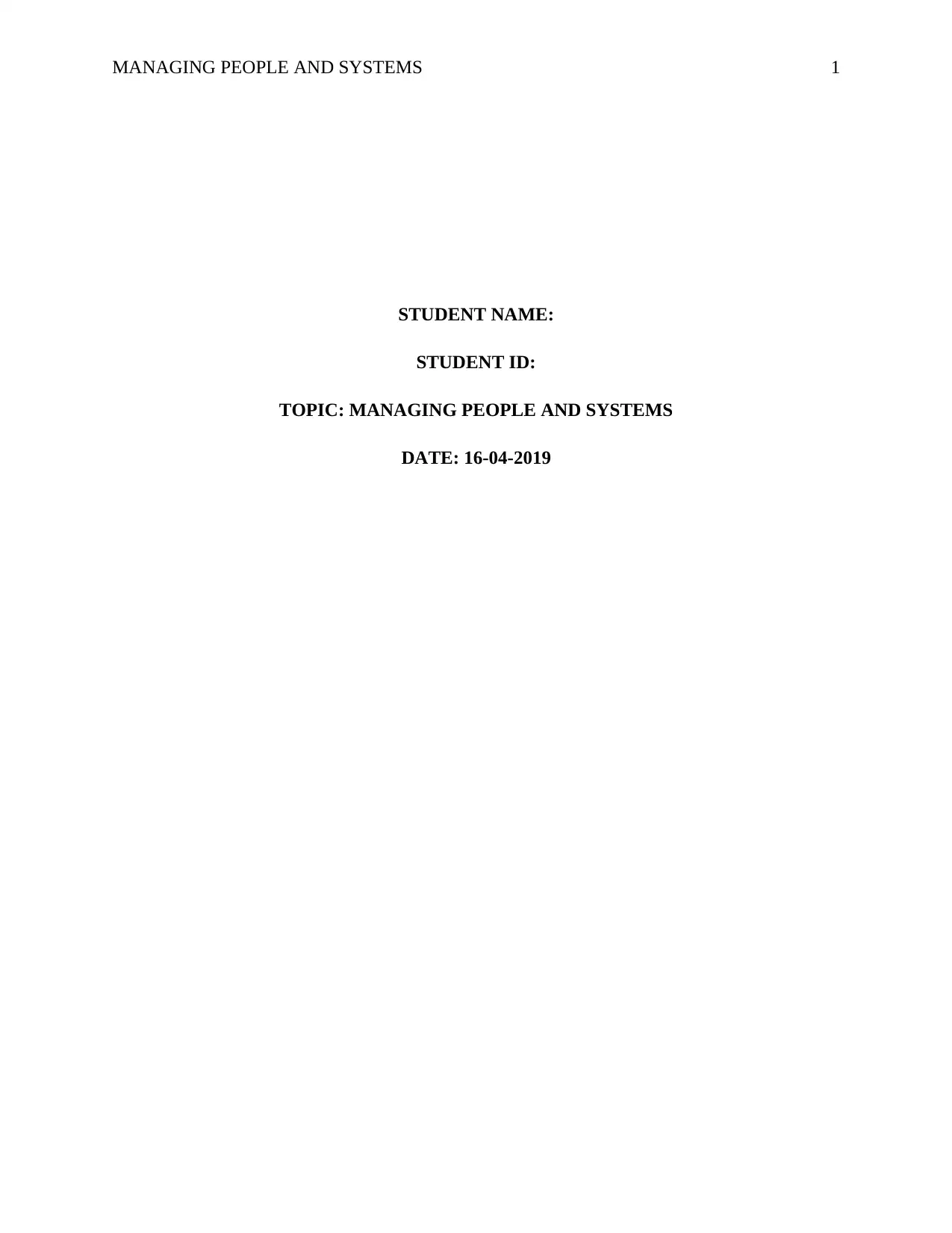
MANAGING PEOPLE AND SYSTEMS 1
STUDENT NAME:
STUDENT ID:
TOPIC: MANAGING PEOPLE AND SYSTEMS
DATE: 16-04-2019
STUDENT NAME:
STUDENT ID:
TOPIC: MANAGING PEOPLE AND SYSTEMS
DATE: 16-04-2019
Paraphrase This Document
Need a fresh take? Get an instant paraphrase of this document with our AI Paraphraser
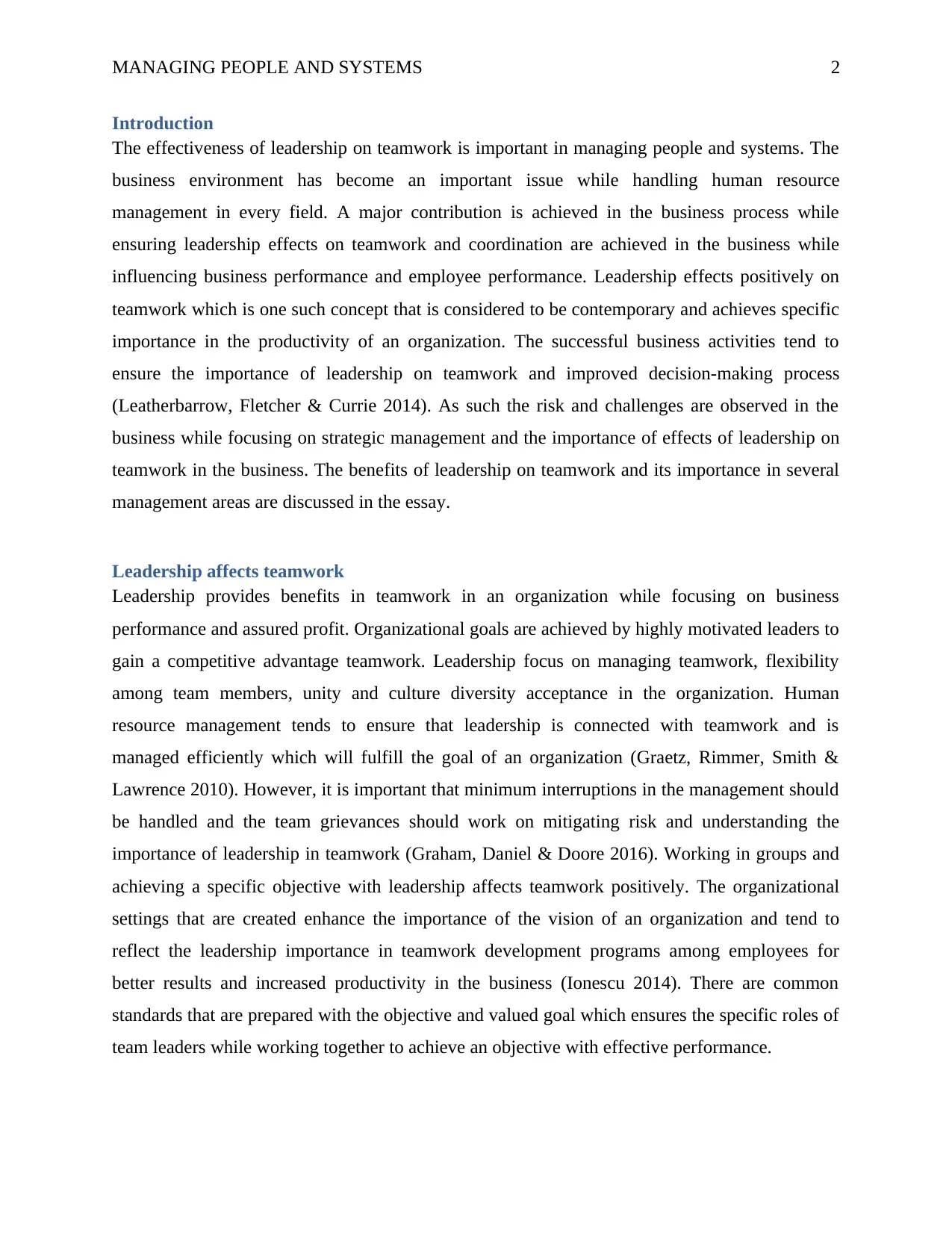
MANAGING PEOPLE AND SYSTEMS 2
Introduction
The effectiveness of leadership on teamwork is important in managing people and systems. The
business environment has become an important issue while handling human resource
management in every field. A major contribution is achieved in the business process while
ensuring leadership effects on teamwork and coordination are achieved in the business while
influencing business performance and employee performance. Leadership effects positively on
teamwork which is one such concept that is considered to be contemporary and achieves specific
importance in the productivity of an organization. The successful business activities tend to
ensure the importance of leadership on teamwork and improved decision-making process
(Leatherbarrow, Fletcher & Currie 2014). As such the risk and challenges are observed in the
business while focusing on strategic management and the importance of effects of leadership on
teamwork in the business. The benefits of leadership on teamwork and its importance in several
management areas are discussed in the essay.
Leadership affects teamwork
Leadership provides benefits in teamwork in an organization while focusing on business
performance and assured profit. Organizational goals are achieved by highly motivated leaders to
gain a competitive advantage teamwork. Leadership focus on managing teamwork, flexibility
among team members, unity and culture diversity acceptance in the organization. Human
resource management tends to ensure that leadership is connected with teamwork and is
managed efficiently which will fulfill the goal of an organization (Graetz, Rimmer, Smith &
Lawrence 2010). However, it is important that minimum interruptions in the management should
be handled and the team grievances should work on mitigating risk and understanding the
importance of leadership in teamwork (Graham, Daniel & Doore 2016). Working in groups and
achieving a specific objective with leadership affects teamwork positively. The organizational
settings that are created enhance the importance of the vision of an organization and tend to
reflect the leadership importance in teamwork development programs among employees for
better results and increased productivity in the business (Ionescu 2014). There are common
standards that are prepared with the objective and valued goal which ensures the specific roles of
team leaders while working together to achieve an objective with effective performance.
Introduction
The effectiveness of leadership on teamwork is important in managing people and systems. The
business environment has become an important issue while handling human resource
management in every field. A major contribution is achieved in the business process while
ensuring leadership effects on teamwork and coordination are achieved in the business while
influencing business performance and employee performance. Leadership effects positively on
teamwork which is one such concept that is considered to be contemporary and achieves specific
importance in the productivity of an organization. The successful business activities tend to
ensure the importance of leadership on teamwork and improved decision-making process
(Leatherbarrow, Fletcher & Currie 2014). As such the risk and challenges are observed in the
business while focusing on strategic management and the importance of effects of leadership on
teamwork in the business. The benefits of leadership on teamwork and its importance in several
management areas are discussed in the essay.
Leadership affects teamwork
Leadership provides benefits in teamwork in an organization while focusing on business
performance and assured profit. Organizational goals are achieved by highly motivated leaders to
gain a competitive advantage teamwork. Leadership focus on managing teamwork, flexibility
among team members, unity and culture diversity acceptance in the organization. Human
resource management tends to ensure that leadership is connected with teamwork and is
managed efficiently which will fulfill the goal of an organization (Graetz, Rimmer, Smith &
Lawrence 2010). However, it is important that minimum interruptions in the management should
be handled and the team grievances should work on mitigating risk and understanding the
importance of leadership in teamwork (Graham, Daniel & Doore 2016). Working in groups and
achieving a specific objective with leadership affects teamwork positively. The organizational
settings that are created enhance the importance of the vision of an organization and tend to
reflect the leadership importance in teamwork development programs among employees for
better results and increased productivity in the business (Ionescu 2014). There are common
standards that are prepared with the objective and valued goal which ensures the specific roles of
team leaders while working together to achieve an objective with effective performance.
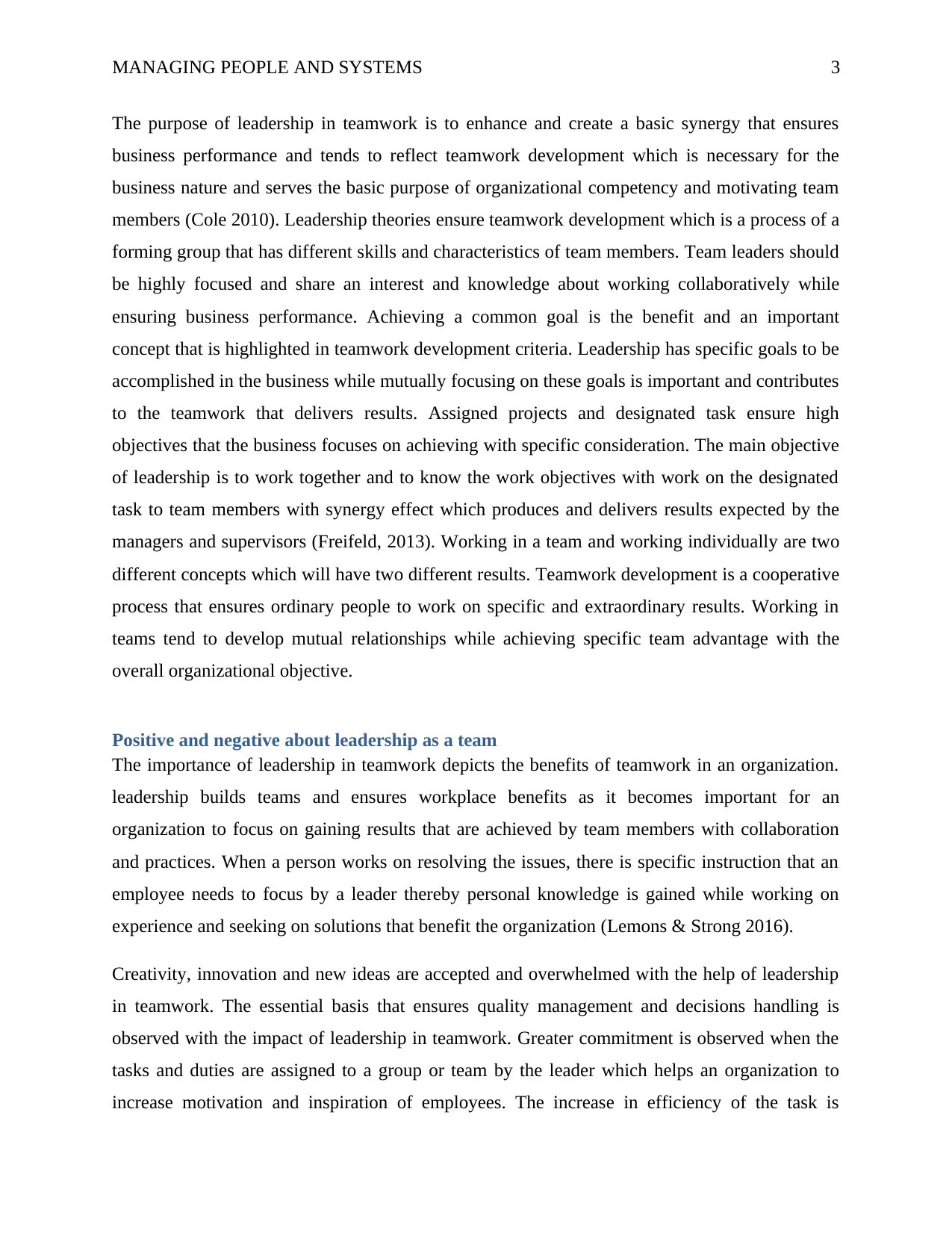
MANAGING PEOPLE AND SYSTEMS 3
The purpose of leadership in teamwork is to enhance and create a basic synergy that ensures
business performance and tends to reflect teamwork development which is necessary for the
business nature and serves the basic purpose of organizational competency and motivating team
members (Cole 2010). Leadership theories ensure teamwork development which is a process of a
forming group that has different skills and characteristics of team members. Team leaders should
be highly focused and share an interest and knowledge about working collaboratively while
ensuring business performance. Achieving a common goal is the benefit and an important
concept that is highlighted in teamwork development criteria. Leadership has specific goals to be
accomplished in the business while mutually focusing on these goals is important and contributes
to the teamwork that delivers results. Assigned projects and designated task ensure high
objectives that the business focuses on achieving with specific consideration. The main objective
of leadership is to work together and to know the work objectives with work on the designated
task to team members with synergy effect which produces and delivers results expected by the
managers and supervisors (Freifeld, 2013). Working in a team and working individually are two
different concepts which will have two different results. Teamwork development is a cooperative
process that ensures ordinary people to work on specific and extraordinary results. Working in
teams tend to develop mutual relationships while achieving specific team advantage with the
overall organizational objective.
Positive and negative about leadership as a team
The importance of leadership in teamwork depicts the benefits of teamwork in an organization.
leadership builds teams and ensures workplace benefits as it becomes important for an
organization to focus on gaining results that are achieved by team members with collaboration
and practices. When a person works on resolving the issues, there is specific instruction that an
employee needs to focus by a leader thereby personal knowledge is gained while working on
experience and seeking on solutions that benefit the organization (Lemons & Strong 2016).
Creativity, innovation and new ideas are accepted and overwhelmed with the help of leadership
in teamwork. The essential basis that ensures quality management and decisions handling is
observed with the impact of leadership in teamwork. Greater commitment is observed when the
tasks and duties are assigned to a group or team by the leader which helps an organization to
increase motivation and inspiration of employees. The increase in efficiency of the task is
The purpose of leadership in teamwork is to enhance and create a basic synergy that ensures
business performance and tends to reflect teamwork development which is necessary for the
business nature and serves the basic purpose of organizational competency and motivating team
members (Cole 2010). Leadership theories ensure teamwork development which is a process of a
forming group that has different skills and characteristics of team members. Team leaders should
be highly focused and share an interest and knowledge about working collaboratively while
ensuring business performance. Achieving a common goal is the benefit and an important
concept that is highlighted in teamwork development criteria. Leadership has specific goals to be
accomplished in the business while mutually focusing on these goals is important and contributes
to the teamwork that delivers results. Assigned projects and designated task ensure high
objectives that the business focuses on achieving with specific consideration. The main objective
of leadership is to work together and to know the work objectives with work on the designated
task to team members with synergy effect which produces and delivers results expected by the
managers and supervisors (Freifeld, 2013). Working in a team and working individually are two
different concepts which will have two different results. Teamwork development is a cooperative
process that ensures ordinary people to work on specific and extraordinary results. Working in
teams tend to develop mutual relationships while achieving specific team advantage with the
overall organizational objective.
Positive and negative about leadership as a team
The importance of leadership in teamwork depicts the benefits of teamwork in an organization.
leadership builds teams and ensures workplace benefits as it becomes important for an
organization to focus on gaining results that are achieved by team members with collaboration
and practices. When a person works on resolving the issues, there is specific instruction that an
employee needs to focus by a leader thereby personal knowledge is gained while working on
experience and seeking on solutions that benefit the organization (Lemons & Strong 2016).
Creativity, innovation and new ideas are accepted and overwhelmed with the help of leadership
in teamwork. The essential basis that ensures quality management and decisions handling is
observed with the impact of leadership in teamwork. Greater commitment is observed when the
tasks and duties are assigned to a group or team by the leader which helps an organization to
increase motivation and inspiration of employees. The increase in efficiency of the task is
⊘ This is a preview!⊘
Do you want full access?
Subscribe today to unlock all pages.

Trusted by 1+ million students worldwide
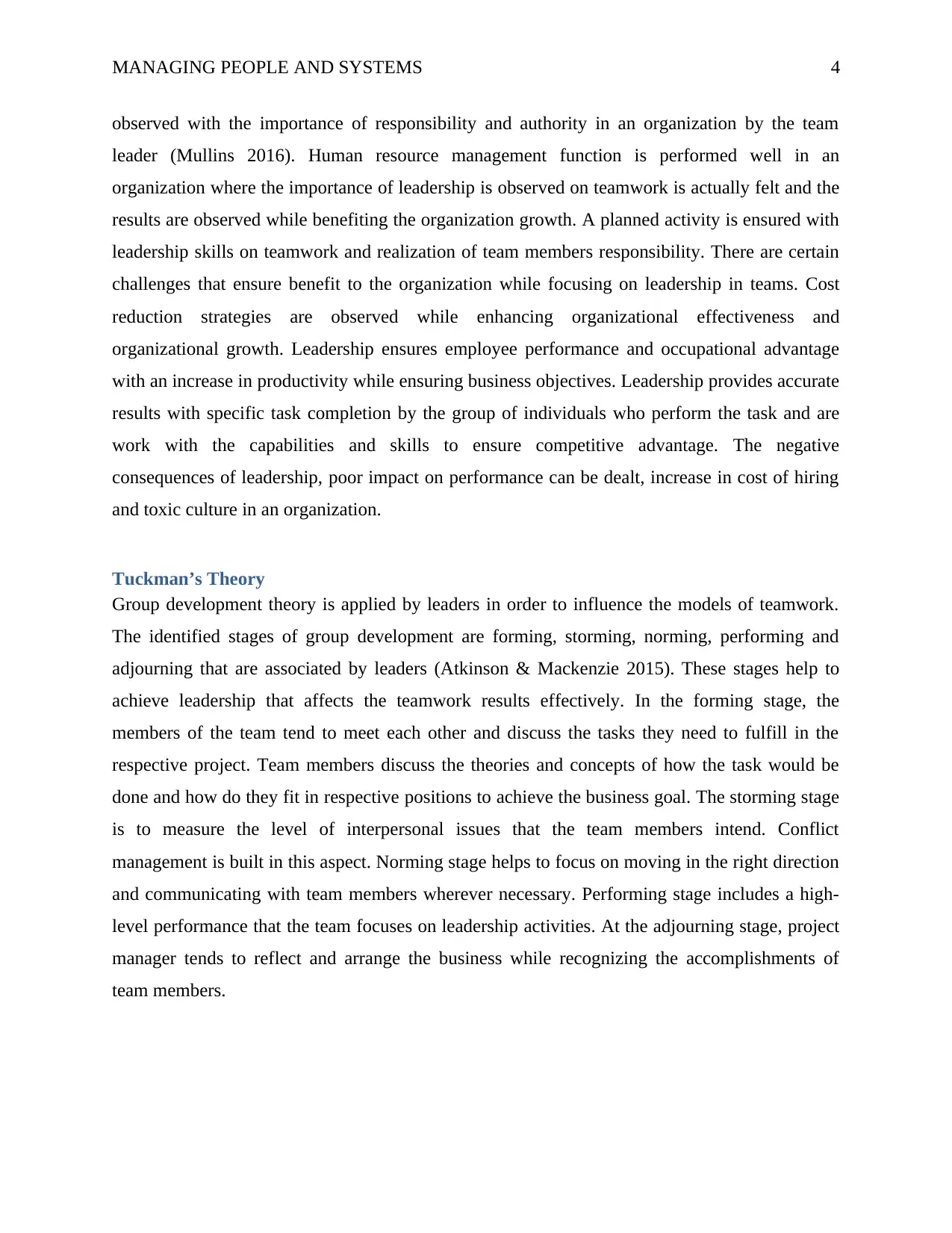
MANAGING PEOPLE AND SYSTEMS 4
observed with the importance of responsibility and authority in an organization by the team
leader (Mullins 2016). Human resource management function is performed well in an
organization where the importance of leadership is observed on teamwork is actually felt and the
results are observed while benefiting the organization growth. A planned activity is ensured with
leadership skills on teamwork and realization of team members responsibility. There are certain
challenges that ensure benefit to the organization while focusing on leadership in teams. Cost
reduction strategies are observed while enhancing organizational effectiveness and
organizational growth. Leadership ensures employee performance and occupational advantage
with an increase in productivity while ensuring business objectives. Leadership provides accurate
results with specific task completion by the group of individuals who perform the task and are
work with the capabilities and skills to ensure competitive advantage. The negative
consequences of leadership, poor impact on performance can be dealt, increase in cost of hiring
and toxic culture in an organization.
Tuckman’s Theory
Group development theory is applied by leaders in order to influence the models of teamwork.
The identified stages of group development are forming, storming, norming, performing and
adjourning that are associated by leaders (Atkinson & Mackenzie 2015). These stages help to
achieve leadership that affects the teamwork results effectively. In the forming stage, the
members of the team tend to meet each other and discuss the tasks they need to fulfill in the
respective project. Team members discuss the theories and concepts of how the task would be
done and how do they fit in respective positions to achieve the business goal. The storming stage
is to measure the level of interpersonal issues that the team members intend. Conflict
management is built in this aspect. Norming stage helps to focus on moving in the right direction
and communicating with team members wherever necessary. Performing stage includes a high-
level performance that the team focuses on leadership activities. At the adjourning stage, project
manager tends to reflect and arrange the business while recognizing the accomplishments of
team members.
observed with the importance of responsibility and authority in an organization by the team
leader (Mullins 2016). Human resource management function is performed well in an
organization where the importance of leadership is observed on teamwork is actually felt and the
results are observed while benefiting the organization growth. A planned activity is ensured with
leadership skills on teamwork and realization of team members responsibility. There are certain
challenges that ensure benefit to the organization while focusing on leadership in teams. Cost
reduction strategies are observed while enhancing organizational effectiveness and
organizational growth. Leadership ensures employee performance and occupational advantage
with an increase in productivity while ensuring business objectives. Leadership provides accurate
results with specific task completion by the group of individuals who perform the task and are
work with the capabilities and skills to ensure competitive advantage. The negative
consequences of leadership, poor impact on performance can be dealt, increase in cost of hiring
and toxic culture in an organization.
Tuckman’s Theory
Group development theory is applied by leaders in order to influence the models of teamwork.
The identified stages of group development are forming, storming, norming, performing and
adjourning that are associated by leaders (Atkinson & Mackenzie 2015). These stages help to
achieve leadership that affects the teamwork results effectively. In the forming stage, the
members of the team tend to meet each other and discuss the tasks they need to fulfill in the
respective project. Team members discuss the theories and concepts of how the task would be
done and how do they fit in respective positions to achieve the business goal. The storming stage
is to measure the level of interpersonal issues that the team members intend. Conflict
management is built in this aspect. Norming stage helps to focus on moving in the right direction
and communicating with team members wherever necessary. Performing stage includes a high-
level performance that the team focuses on leadership activities. At the adjourning stage, project
manager tends to reflect and arrange the business while recognizing the accomplishments of
team members.
Paraphrase This Document
Need a fresh take? Get an instant paraphrase of this document with our AI Paraphraser
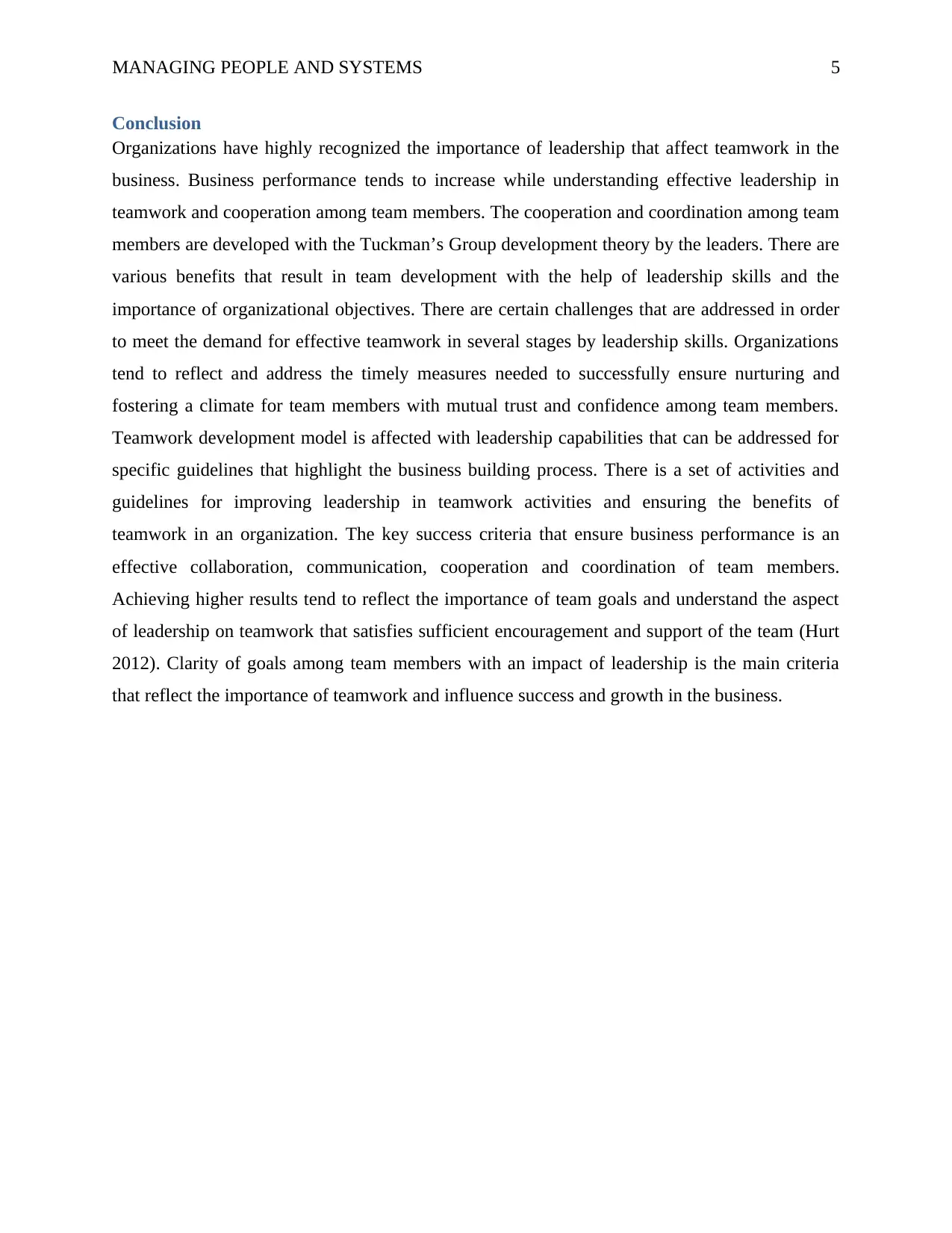
MANAGING PEOPLE AND SYSTEMS 5
Conclusion
Organizations have highly recognized the importance of leadership that affect teamwork in the
business. Business performance tends to increase while understanding effective leadership in
teamwork and cooperation among team members. The cooperation and coordination among team
members are developed with the Tuckman’s Group development theory by the leaders. There are
various benefits that result in team development with the help of leadership skills and the
importance of organizational objectives. There are certain challenges that are addressed in order
to meet the demand for effective teamwork in several stages by leadership skills. Organizations
tend to reflect and address the timely measures needed to successfully ensure nurturing and
fostering a climate for team members with mutual trust and confidence among team members.
Teamwork development model is affected with leadership capabilities that can be addressed for
specific guidelines that highlight the business building process. There is a set of activities and
guidelines for improving leadership in teamwork activities and ensuring the benefits of
teamwork in an organization. The key success criteria that ensure business performance is an
effective collaboration, communication, cooperation and coordination of team members.
Achieving higher results tend to reflect the importance of team goals and understand the aspect
of leadership on teamwork that satisfies sufficient encouragement and support of the team (Hurt
2012). Clarity of goals among team members with an impact of leadership is the main criteria
that reflect the importance of teamwork and influence success and growth in the business.
Conclusion
Organizations have highly recognized the importance of leadership that affect teamwork in the
business. Business performance tends to increase while understanding effective leadership in
teamwork and cooperation among team members. The cooperation and coordination among team
members are developed with the Tuckman’s Group development theory by the leaders. There are
various benefits that result in team development with the help of leadership skills and the
importance of organizational objectives. There are certain challenges that are addressed in order
to meet the demand for effective teamwork in several stages by leadership skills. Organizations
tend to reflect and address the timely measures needed to successfully ensure nurturing and
fostering a climate for team members with mutual trust and confidence among team members.
Teamwork development model is affected with leadership capabilities that can be addressed for
specific guidelines that highlight the business building process. There is a set of activities and
guidelines for improving leadership in teamwork activities and ensuring the benefits of
teamwork in an organization. The key success criteria that ensure business performance is an
effective collaboration, communication, cooperation and coordination of team members.
Achieving higher results tend to reflect the importance of team goals and understand the aspect
of leadership on teamwork that satisfies sufficient encouragement and support of the team (Hurt
2012). Clarity of goals among team members with an impact of leadership is the main criteria
that reflect the importance of teamwork and influence success and growth in the business.
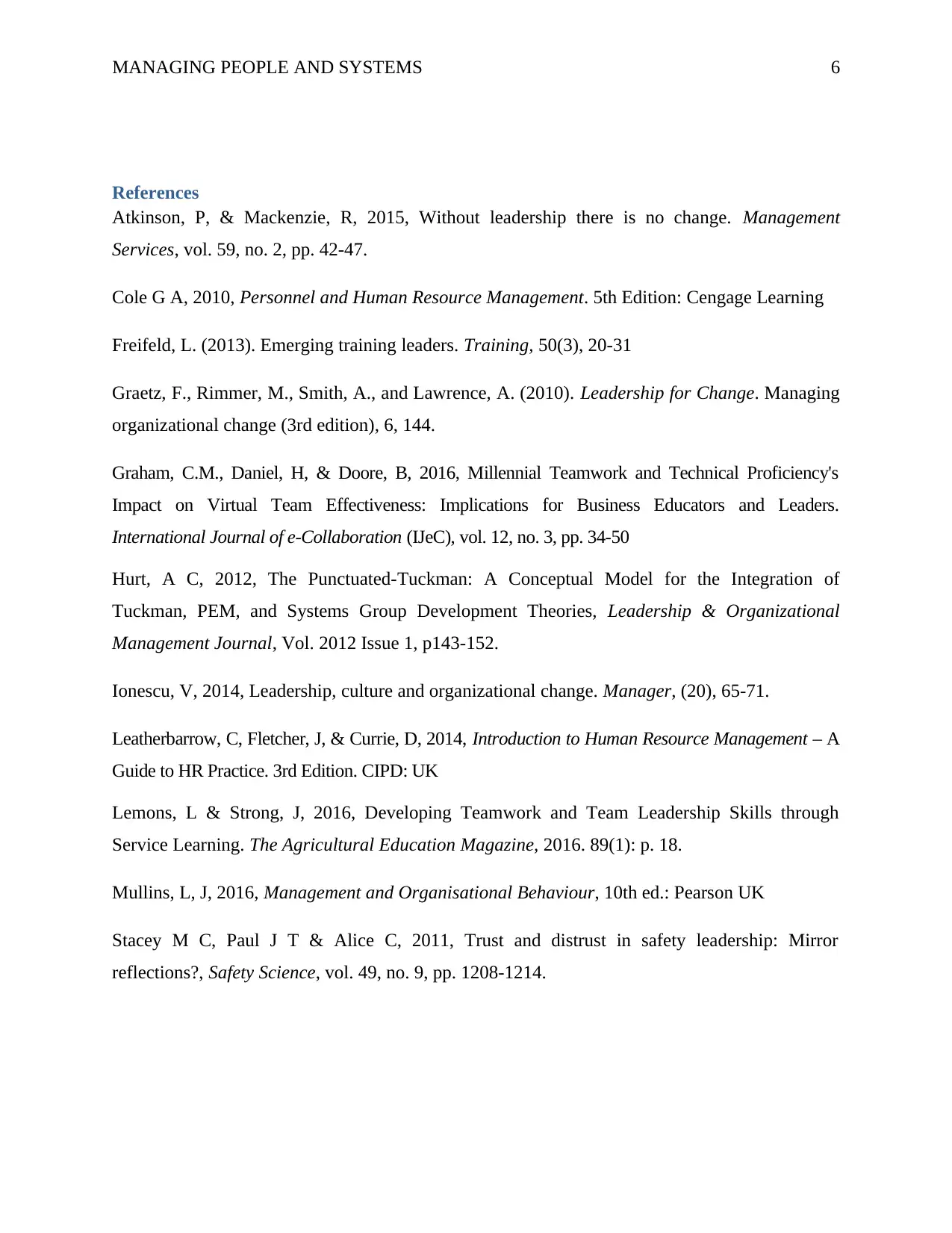
MANAGING PEOPLE AND SYSTEMS 6
References
Atkinson, P, & Mackenzie, R, 2015, Without leadership there is no change. Management
Services, vol. 59, no. 2, pp. 42-47.
Cole G A, 2010, Personnel and Human Resource Management. 5th Edition: Cengage Learning
Freifeld, L. (2013). Emerging training leaders. Training, 50(3), 20-31
Graetz, F., Rimmer, M., Smith, A., and Lawrence, A. (2010). Leadership for Change. Managing
organizational change (3rd edition), 6, 144.
Graham, C.M., Daniel, H, & Doore, B, 2016, Millennial Teamwork and Technical Proficiency's
Impact on Virtual Team Effectiveness: Implications for Business Educators and Leaders.
International Journal of e-Collaboration (IJeC), vol. 12, no. 3, pp. 34-50
Hurt, A C, 2012, The Punctuated-Tuckman: A Conceptual Model for the Integration of
Tuckman, PEM, and Systems Group Development Theories, Leadership & Organizational
Management Journal, Vol. 2012 Issue 1, p143-152.
Ionescu, V, 2014, Leadership, culture and organizational change. Manager, (20), 65-71.
Leatherbarrow, C, Fletcher, J, & Currie, D, 2014, Introduction to Human Resource Management – A
Guide to HR Practice. 3rd Edition. CIPD: UK
Lemons, L & Strong, J, 2016, Developing Teamwork and Team Leadership Skills through
Service Learning. The Agricultural Education Magazine, 2016. 89(1): p. 18.
Mullins, L, J, 2016, Management and Organisational Behaviour, 10th ed.: Pearson UK
Stacey M C, Paul J T & Alice C, 2011, Trust and distrust in safety leadership: Mirror
reflections?, Safety Science, vol. 49, no. 9, pp. 1208-1214.
References
Atkinson, P, & Mackenzie, R, 2015, Without leadership there is no change. Management
Services, vol. 59, no. 2, pp. 42-47.
Cole G A, 2010, Personnel and Human Resource Management. 5th Edition: Cengage Learning
Freifeld, L. (2013). Emerging training leaders. Training, 50(3), 20-31
Graetz, F., Rimmer, M., Smith, A., and Lawrence, A. (2010). Leadership for Change. Managing
organizational change (3rd edition), 6, 144.
Graham, C.M., Daniel, H, & Doore, B, 2016, Millennial Teamwork and Technical Proficiency's
Impact on Virtual Team Effectiveness: Implications for Business Educators and Leaders.
International Journal of e-Collaboration (IJeC), vol. 12, no. 3, pp. 34-50
Hurt, A C, 2012, The Punctuated-Tuckman: A Conceptual Model for the Integration of
Tuckman, PEM, and Systems Group Development Theories, Leadership & Organizational
Management Journal, Vol. 2012 Issue 1, p143-152.
Ionescu, V, 2014, Leadership, culture and organizational change. Manager, (20), 65-71.
Leatherbarrow, C, Fletcher, J, & Currie, D, 2014, Introduction to Human Resource Management – A
Guide to HR Practice. 3rd Edition. CIPD: UK
Lemons, L & Strong, J, 2016, Developing Teamwork and Team Leadership Skills through
Service Learning. The Agricultural Education Magazine, 2016. 89(1): p. 18.
Mullins, L, J, 2016, Management and Organisational Behaviour, 10th ed.: Pearson UK
Stacey M C, Paul J T & Alice C, 2011, Trust and distrust in safety leadership: Mirror
reflections?, Safety Science, vol. 49, no. 9, pp. 1208-1214.
⊘ This is a preview!⊘
Do you want full access?
Subscribe today to unlock all pages.

Trusted by 1+ million students worldwide
1 out of 6
Related Documents
Your All-in-One AI-Powered Toolkit for Academic Success.
+13062052269
info@desklib.com
Available 24*7 on WhatsApp / Email
![[object Object]](/_next/static/media/star-bottom.7253800d.svg)
Unlock your academic potential
Copyright © 2020–2025 A2Z Services. All Rights Reserved. Developed and managed by ZUCOL.





